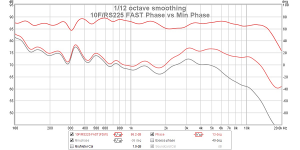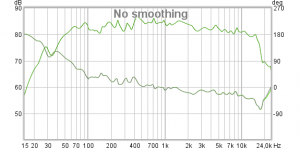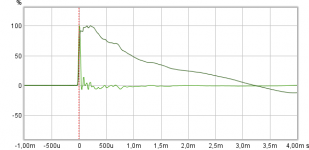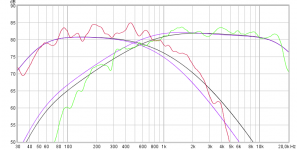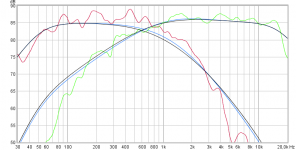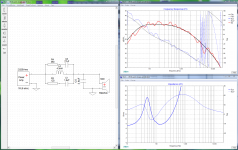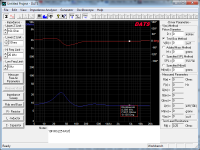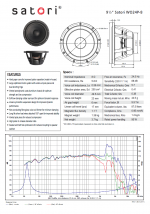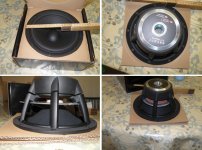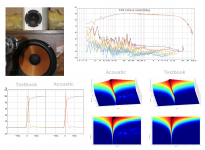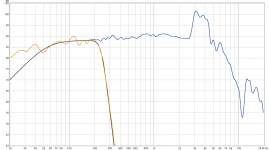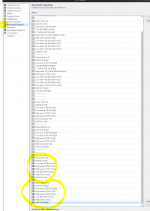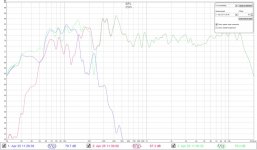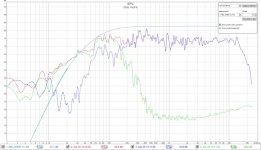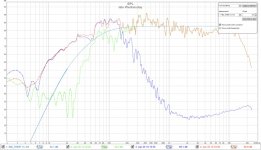Hi Byrtt,
I know you think that the RS225-8 aluminum cone has problematic breakup as you show so prominently above. But in reality, adding a simple 4.4uF and 0.47ohm filter across the terminals pretty much effectively gets rid of it. See XO plot below.
XO design currently used:
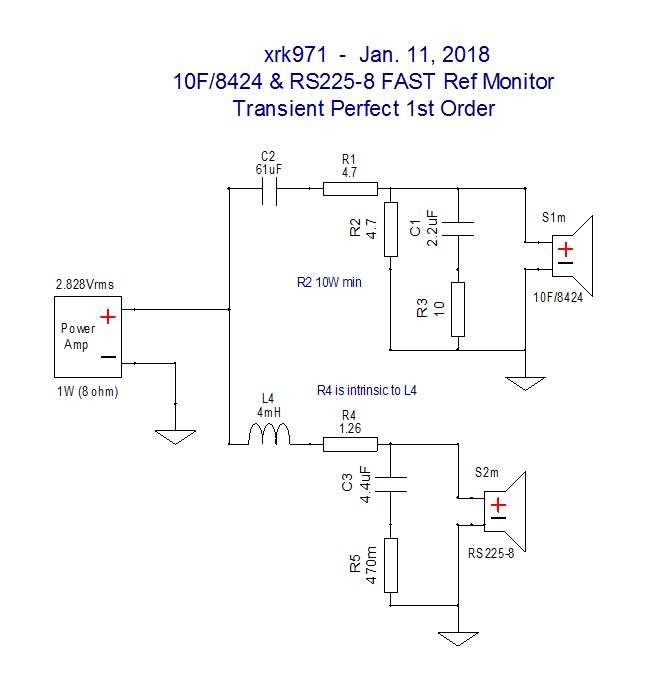
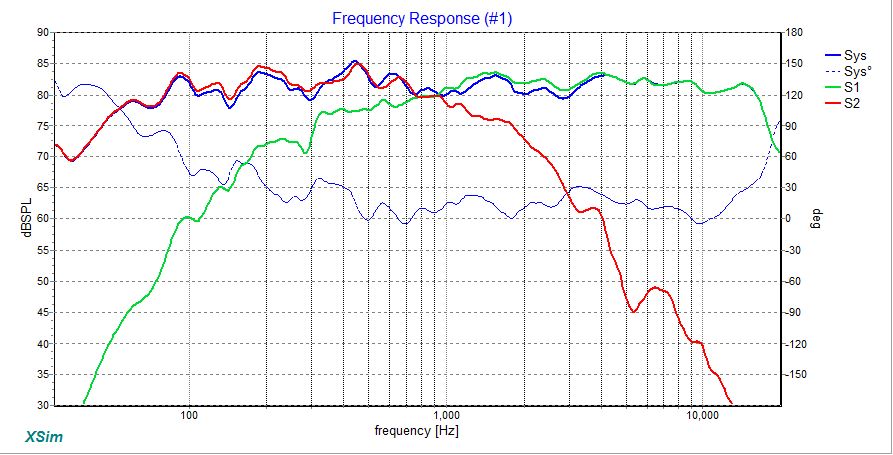
XO is closer to 900Hz in practice but due to wide bandwidth of both drivers I don’t think it matters much is it’s 600Hz or 900Hz.
Here is predicted square wave response at 1kHz for about equal contributions from RS225 and from 10F:
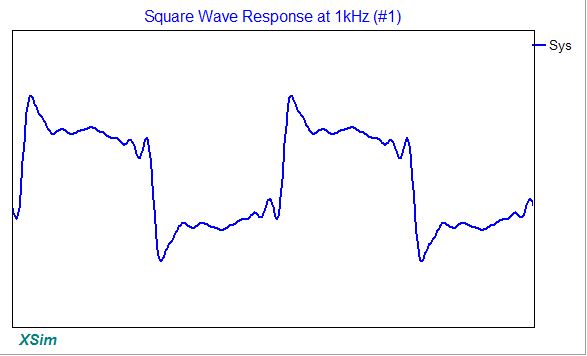
And in fact, listening to the speakers in comparison to headphones at the same position the speakers sound very nice. Similar response and balance and overall feel.
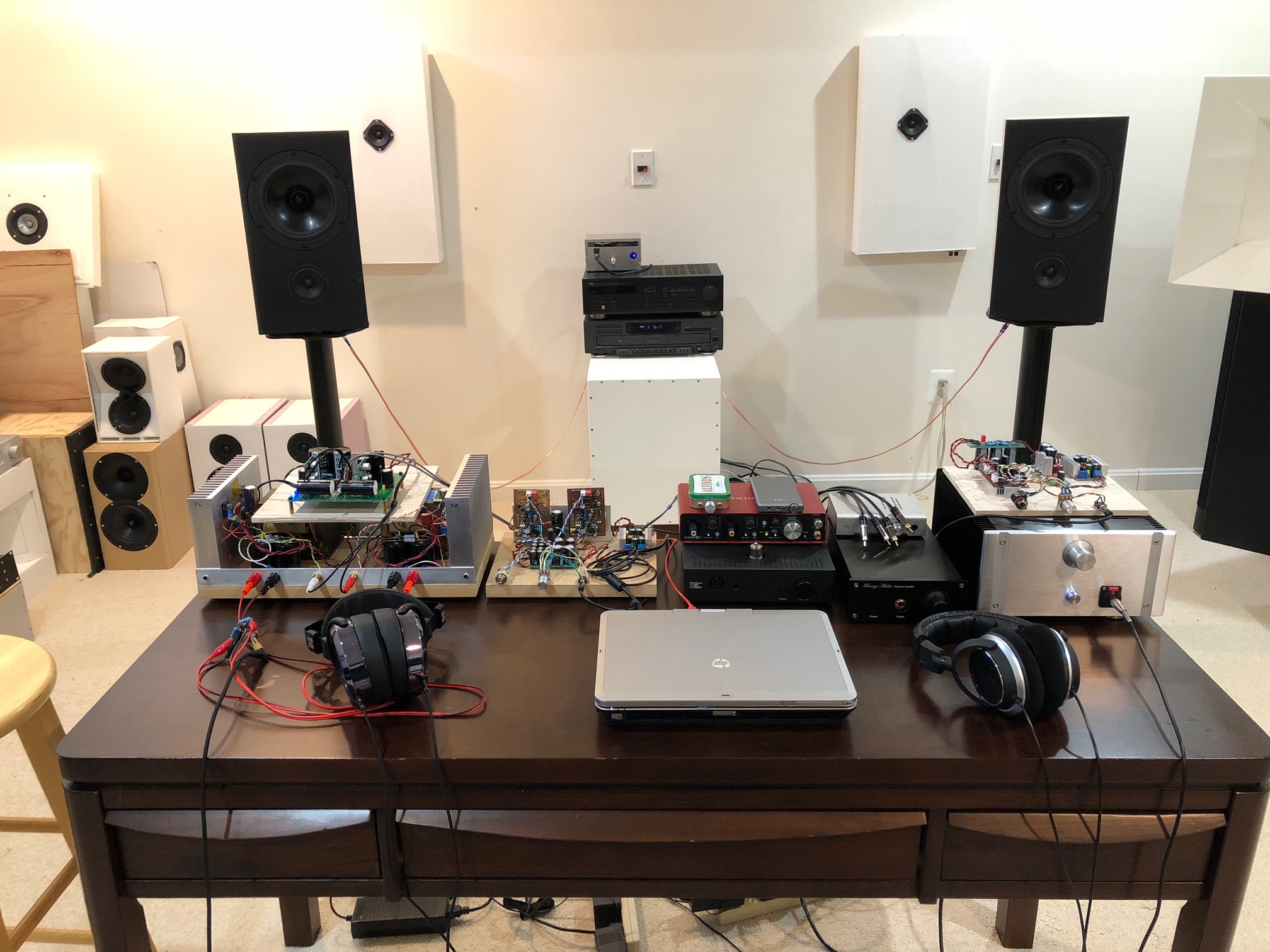
I know you think that the RS225-8 aluminum cone has problematic breakup as you show so prominently above. But in reality, adding a simple 4.4uF and 0.47ohm filter across the terminals pretty much effectively gets rid of it. See XO plot below.
XO design currently used:
XO is closer to 900Hz in practice but due to wide bandwidth of both drivers I don’t think it matters much is it’s 600Hz or 900Hz.
Here is predicted square wave response at 1kHz for about equal contributions from RS225 and from 10F:
And in fact, listening to the speakers in comparison to headphones at the same position the speakers sound very nice. Similar response and balance and overall feel.
Last edited:
Hi Byrtt,
I know you think that the RS225-8 aluminum cone has problematic breakup as you show so prominently above. But in reality, adding a simple 4.4uF and 0.47ohm filter across the terminals pretty much effectively gets rid of it. See XO plot below...
Shure on your XSim graph that design axis slope looks nice but then it loose its wideband quality compared to how a named 1st order slope would have looked and end up be a designed waveshape distortion element that the absolute phase verse MP phase back in post 577 shown attached below makes clear over a wide range starting in area 600-800Hz and up, in diy world designer can probably stop here knowing he listen to his own homebrew math of summing slopes, in pro world to take advantage of a math scheme named 1st order slope it takes more than that to call it a name and keep wave shape non distorted as it supposed to be.
To really call it 1st order transient perfect and superior to design compromise using Harsch slopes see below pointers how your objective amplitude data post 573 should look on design axis, and its not about be within either plus or minus 20-25º relative to flat phase to have a transient perfect wave shape its about be close to textbook prediction else there is non intended wave shape distortion to deal with or else call it something else to be transparent about it. Can't know but there is probably reasons why very few products claim acoustic 1st order slopes, what i know from hobby trials is that subjective sound will change enormous fixing a small design error in a 1st order system compared to small fixes for higher order systems.
Attachments
...XO design currently used...
Attached zip folders below are two set of weird target slopes that are transient perfect maybe they worth a try.
Attachments
...XO design currently used...
Alternative to black from previous post is this blue target attached below, not much difference from black but still maybe advantageous when drivers coverage is on the edge.
BTW using the old XSim project file from 2015 where RS225 was measured on a bit different design axis below attached XSim network can hit the black target fairly good, with the notice in below network RS225 response from 300Hz and up is very less damped compared to 10F so maybe its a good idea add inductance compensation network for RS225.
Attachments
Last edited:
Thanks for RS225 inductance compensation network, Byrtt. I am not sure if that is really needed considering the measured impedance response for the speaker system as a function of frequency. It looks fairly benign as XO’s go varying from 7.5ohms to 25ohms without any major peaks.
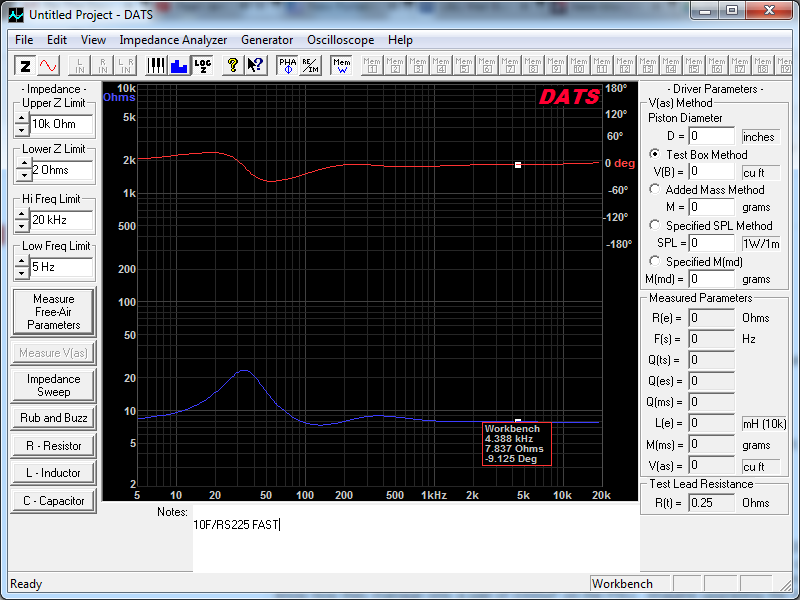
Attachments
Member
Joined 2009
Paid Member
How big a woofer?
Without size restrictions, I'd go for a 15" for sure.
Faital makes some nice ones, and Dayton might be ok too.
You'd want a highish Qts (if going OB) driver that extends to about 800Hz without any huge breaks higher up, so it should be easy to integrate passively if you go that route.
As for XO, using a miniDSP, I was able to try anything from a simple 1st order to the Harsch... to me, the Harsch wins every time. But only really feasible with a miniDSP at the low frequency XO we are using. Cost would be prohibitive going passively so low.
Without size restrictions, I'd go for a 15" for sure.
Faital makes some nice ones, and Dayton might be ok too.
You'd want a highish Qts (if going OB) driver that extends to about 800Hz without any huge breaks higher up, so it should be easy to integrate passively if you go that route.
As for XO, using a miniDSP, I was able to try anything from a simple 1st order to the Harsch... to me, the Harsch wins every time. But only really feasible with a miniDSP at the low frequency XO we are using. Cost would be prohibitive going passively so low.
Hi Bigun and perceval,
Of course think perceval is right the more area and displacement the lower the distortion and man the few controlled frozen low SPL trials i had been able to run for speaker system or head phones where woofer distortion gets into a over average very low numbers sounds to die for but also a little bit scary that it sounds actually different to what one had become mostly used to over life time. First i was close to plan for 8x SN17NRXC35 (6 incher) in a line array with one 10F to get overkill in woofer area and displacement and at same get the area below 500Hz out to listening position without the usual floor and ceiling bouncing problems but then discovered that line array fall only half per doubling of distance compared to 10F point source and that's not a compromise i like then thinks it sounds better to use one way array system with say 20-30 TC9 drivers per side without any XO networks or woofers. If costs is not a restriction as bigun ask then think if we follow what info member TMM share over time spread around all over this forum that top model woofers from SS and SBA have that excellent performance and features and therefor lately took me together and bought one of SBA's SATORI WO24P-8 for trials paired with 10F for a on wall FAST system. Good thing is its not terrible expensive as some of the SS models are and at present i really can't recommend it to others as a superior woofer paired to 10F, but give me some months of trials and I get back with some data to share for Bigun and others. SBA categorize it as 9,5 inch but its frame is only 10mm more diameter than the very low numbers of distortion than bushmeister got out of SBA 8 incher SB23NRXS45-8 model. A couple of reason i don't use bigger diameter woofer hang together realized my actual room only need about a 56Hz 2nd to 3rd roll off and that woofer can manage 46Hz in a normal sealed Q0,7 enclosure so when filtered with a LT from 46Hz Q0,7 up to 56Hz Q>0,7 should actual also lower woofer distortion a bit, other reason is for more than a year have run ctc distance within 1/8 wavelength and when combined with 96dB/oct LR filter perform as a one point source without power response errors in XO region and is a hard to live without feature when one has get used to it. Admit my plans would probably not work in a passive world and needs some active DSP with all the power it can get, third visual below show system as of june 2017 running JRiver DSP locked at 96kHz where the new one will be upped to 192kHz which makes one in control of how HF roll off will ring out including devices as amps tweeter and ADC/DACs, and hope is with a new enclosure with 3 inch radius round overs plus the new woofer and a 240Hz XO point verse the present 180Hz will up this system to better distortion numbers.
Of course think perceval is right the more area and displacement the lower the distortion and man the few controlled frozen low SPL trials i had been able to run for speaker system or head phones where woofer distortion gets into a over average very low numbers sounds to die for but also a little bit scary that it sounds actually different to what one had become mostly used to over life time. First i was close to plan for 8x SN17NRXC35 (6 incher) in a line array with one 10F to get overkill in woofer area and displacement and at same get the area below 500Hz out to listening position without the usual floor and ceiling bouncing problems but then discovered that line array fall only half per doubling of distance compared to 10F point source and that's not a compromise i like then thinks it sounds better to use one way array system with say 20-30 TC9 drivers per side without any XO networks or woofers. If costs is not a restriction as bigun ask then think if we follow what info member TMM share over time spread around all over this forum that top model woofers from SS and SBA have that excellent performance and features and therefor lately took me together and bought one of SBA's SATORI WO24P-8 for trials paired with 10F for a on wall FAST system. Good thing is its not terrible expensive as some of the SS models are and at present i really can't recommend it to others as a superior woofer paired to 10F, but give me some months of trials and I get back with some data to share for Bigun and others. SBA categorize it as 9,5 inch but its frame is only 10mm more diameter than the very low numbers of distortion than bushmeister got out of SBA 8 incher SB23NRXS45-8 model. A couple of reason i don't use bigger diameter woofer hang together realized my actual room only need about a 56Hz 2nd to 3rd roll off and that woofer can manage 46Hz in a normal sealed Q0,7 enclosure so when filtered with a LT from 46Hz Q0,7 up to 56Hz Q>0,7 should actual also lower woofer distortion a bit, other reason is for more than a year have run ctc distance within 1/8 wavelength and when combined with 96dB/oct LR filter perform as a one point source without power response errors in XO region and is a hard to live without feature when one has get used to it. Admit my plans would probably not work in a passive world and needs some active DSP with all the power it can get, third visual below show system as of june 2017 running JRiver DSP locked at 96kHz where the new one will be upped to 192kHz which makes one in control of how HF roll off will ring out including devices as amps tweeter and ADC/DACs, and hope is with a new enclosure with 3 inch radius round overs plus the new woofer and a 240Hz XO point verse the present 180Hz will up this system to better distortion numbers.
Attachments
Member
Joined 2009
Paid Member
Hi Brytt,
The FR for the Satori has horrible peaks, which have to be supressed, so why did you choose this ?
When I think about the time and effort neded to design and build a good speaker I realize that it is significant. Reading your posts makes it clear to me that one must put in time to understand the finer points, have the discipline to exercise attention to detail. Most likely I would not develop any good speakers first time, as experience is so important so I try to ask questions here and there! As for DIY we are building for ourselves it makes no sense to choose low cost parts unless they are v good, it makes more sense to pick good parts that will ease the journey and make it more likely to achieve good results. This is why I was thinking to ignore cost, but of course it should be sensible!
For speaker design I am a learner, with only experience of single driver full range. I am curious about multi driver because of the compromises in full range that I experienced. But there are so many new compromises in 2way to understand. I wonder if coax is a good place to start for transient perfect instead of Harsch?
The FR for the Satori has horrible peaks, which have to be supressed, so why did you choose this ?
When I think about the time and effort neded to design and build a good speaker I realize that it is significant. Reading your posts makes it clear to me that one must put in time to understand the finer points, have the discipline to exercise attention to detail. Most likely I would not develop any good speakers first time, as experience is so important so I try to ask questions here and there! As for DIY we are building for ourselves it makes no sense to choose low cost parts unless they are v good, it makes more sense to pick good parts that will ease the journey and make it more likely to achieve good results. This is why I was thinking to ignore cost, but of course it should be sensible!
For speaker design I am a learner, with only experience of single driver full range. I am curious about multi driver because of the compromises in full range that I experienced. But there are so many new compromises in 2way to understand. I wonder if coax is a good place to start for transient perfect instead of Harsch?
Last edited:
That Satori is fine for a Harsch XO, since the woofer is a 4th order, cutting it in between 500 to 800 should be ok.
On another note, how about some of that Fane people have been raving lately, in the 12 or 15" version, and add a nice ribbon tweeter on top to air it out?
I've been looking at something similar lately.
A killer setup that may happen someday for me would be a nice Faital woofer, and an ESS Heil Air Motion... Wouldn't be low cost, but I think it would be money well spent.
On another note, how about some of that Fane people have been raving lately, in the 12 or 15" version, and add a nice ribbon tweeter on top to air it out?
I've been looking at something similar lately.
A killer setup that may happen someday for me would be a nice Faital woofer, and an ESS Heil Air Motion... Wouldn't be low cost, but I think it would be money well spent.
Hi Bigun,
In principle also like single driver full range very much but realize its compromises real world, so to up its performance there's a need to go multi-way and hope 2 way is enough else have plans for 3 way with 10F but it gets complicated so hope is this new 2 way trial setup will suit my needs.
About that SATORI will expect all the attention that had been put into its huge ventilation windows and other stuff will pay back with good real world numbers and that horrible peak is not loved but its up so high that it shouldn't be any problem. Below blue trace show datasheet curve plus black trace for my band-pass target and if we take that raw datasheet curve times a low pass textbook 96db/oct LR we get that orange trace and as can be seen looking -50dB down looks absolut fine, but then again because i can and have all the DSP power one can dream off i intend to EQ that raw curve flat before it gets LR low passed.
With more and more devices that pops up agree coax start looking interesting and transient perfect or not it gets XO point region dispersion to behave excellent as a real one point source, its the same reason i use full ranger as mid-tweeter and build its ctc distance within 1/8 wavelength because if that is combined with LR 96dB/oct we very close to what coax perform.
In principle also like single driver full range very much but realize its compromises real world, so to up its performance there's a need to go multi-way and hope 2 way is enough else have plans for 3 way with 10F but it gets complicated so hope is this new 2 way trial setup will suit my needs.
About that SATORI will expect all the attention that had been put into its huge ventilation windows and other stuff will pay back with good real world numbers and that horrible peak is not loved but its up so high that it shouldn't be any problem. Below blue trace show datasheet curve plus black trace for my band-pass target and if we take that raw datasheet curve times a low pass textbook 96db/oct LR we get that orange trace and as can be seen looking -50dB down looks absolut fine, but then again because i can and have all the DSP power one can dream off i intend to EQ that raw curve flat before it gets LR low passed.
With more and more devices that pops up agree coax start looking interesting and transient perfect or not it gets XO point region dispersion to behave excellent as a real one point source, its the same reason i use full ranger as mid-tweeter and build its ctc distance within 1/8 wavelength because if that is combined with LR 96dB/oct we very close to what coax perform.
Attachments
Last edited:
That Satori is fine for a Harsch XO, since the woofer is a 4th order, cutting it in between 500 to 800 should be ok...
Agree should be fine say below 500Hz when low passed 4th order or more.
...On another note, how about some of that Fane people have been raving lately, in the 12 or 15" version, and add a nice ribbon tweeter on top to air it out?...
Be aware many whizzers have a acoustic mechanical XO point that adds excess phase shift same way as minimum phase electric networks do and you can see it in REW ask it to plot minimum phase curve that belongs to actual amplitude response using "Controls" "Generate minimum phase" and also waterfalls would be distorted by that point of delay. Don't think such mechanical feature is most linear and easy to work with and smooth out using upstream electric correction, for example if raw measurement is a precise basement one can correct a TC9 or 10F with a inverse electric correction curve upstream and driver starts to sound smooth as was it pure silk as long as ears is within a closer distance than any nasty reflection points, where my personal trials with whizzer cones never gets to that point of smooth clean magic without a layer of some buzzing signature, although will expect one can get rid of that added layer if driver is low passed and used below the mechanical XO point.
...I've been looking at something similar lately.
A killer setup that may happen someday for me would be a nice Faital woofer, and an ESS Heil Air Motion... Wouldn't be low cost, but I think it would be money well spent.
Thoughts sounds really good and driver by driver pass band bet they probably can perform excellent, problem is often real world implementation to get their cooperation work perfect in room setup and for all track materials : )
for my OB 12" woofer and audionirvana clasisc 8", I'd like to use passive xo on AN and use behringer nu3000dsp for woofer. any advise whether this is a good path for passive approach before i buy passive xo parts? I'm thinking about 200Hz HPF for AN, maybe it does not need any delay for this low fc.
for my OB 12" woofer and audionirvana clasisc 8", I'd like to use passive xo on AN and use behringer nu3000dsp for woofer. any advise whether this is a good path for passive approach before i buy passive xo parts? I'm thinking about 200Hz HPF for AN, maybe it does not need any delay for this low fc.
Hi gadut,
To be a pure Harsh filter at 200Hz it will need AN relative delayed 2,5mS (1/200 x 0,5) or physical offset about 85,75cm behind woofers acoustic center, and looking at your nice OB pictures it looks there's a super tweeter involved in system that also need that delay or physical offset, so my 2 cents would be if you end use a electric device in chain to achieve delay its smarter get a device that at same can dial in the XO slope.
Hi gadut,
Often i get the feeling OB fans are about as pure a chain with less devices as possible and that's probably a very fine and enjoyable diy road, should you ever down the road decide to investigate your curiosity my comment will be that a sloppy setup including DSP and more boxes will sound as more boxes and a DSP steered speaker but with some care and exercise down the road one can get it to sound as pure and analog as without those devices and often we get so much correction power in DSP engines compared to passive analogs that overall system distortion will improve some.
If you really like to hear what Harsch verse LR2/LR4/BW1 can bring try a player as JRiver or Foobar, because its possible using head phones and set up DSP engine so it split L/R channels out into AUX busses then add XO points and delays and downstream sum them again to normal L/R channels, this way you can compare how it sounds into a controlled acoustic head phone environment. As example see below how it could look in JRiver marked with yellow for Harsch, some of the filters above is for BW1 and LR2/LR4 and can be ticked on for listening trials.
Often i get the feeling OB fans are about as pure a chain with less devices as possible and that's probably a very fine and enjoyable diy road, should you ever down the road decide to investigate your curiosity my comment will be that a sloppy setup including DSP and more boxes will sound as more boxes and a DSP steered speaker but with some care and exercise down the road one can get it to sound as pure and analog as without those devices and often we get so much correction power in DSP engines compared to passive analogs that overall system distortion will improve some.
If you really like to hear what Harsch verse LR2/LR4/BW1 can bring try a player as JRiver or Foobar, because its possible using head phones and set up DSP engine so it split L/R channels out into AUX busses then add XO points and delays and downstream sum them again to normal L/R channels, this way you can compare how it sounds into a controlled acoustic head phone environment. As example see below how it could look in JRiver marked with yellow for Harsch, some of the filters above is for BW1 and LR2/LR4 and can be ticked on for listening trials.
Attachments
Last edited:
- Home
- Loudspeakers
- Multi-Way
- S. Harsch XO
